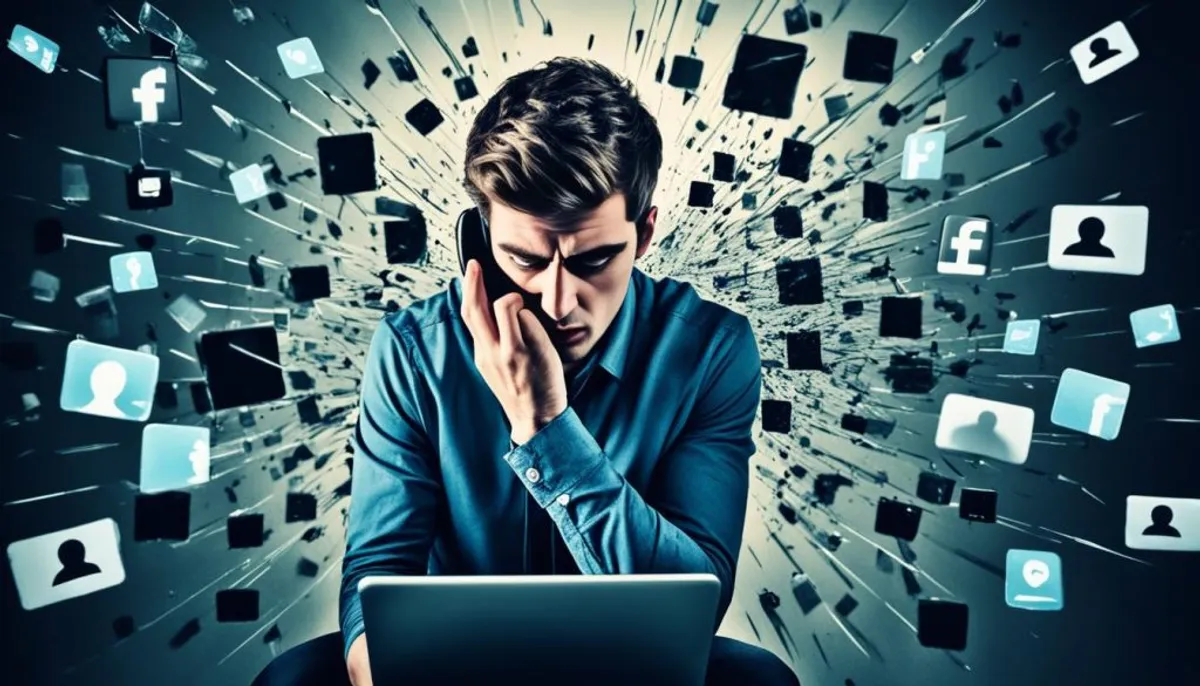Social networks are now a big part of our lives. They connect us with friends, family, and communities. But, they also bring cyberbullying, a big problem.
Cyberbullying is when people use technology to harass or humiliate others. It’s a big issue, especially for teens. A study by the Pew Research Center found 46% of teens have been cyberbullied. This shows we need to take action.

This article will look into cyberbullying and its effects. We’ll see how it impacts people and communities. We’ll also talk about ways to fight this problem. By understanding online harassment and its effects, we can make the internet safer for everyone.
Understanding Cyberbullying and Its Impact
In today’s digital world, cyberbullying is a big problem. It includes mean behaviors done online, on social media, and through devices. Cyberbullying, online harassment, and digital abuse can be many things. This includes sending mean messages, spreading lies, posting embarrassing stuff, or pretending to be someone else online.
Cyberbullying is special because people can stay hidden online. This makes it hard for victims to find out who is bullying them. Also, once something is online, it can stay there forever. This means the hurt can keep going long after the first time.
Definition and Dynamics of Cyberbullying
Cyberbullying is when people use digital tools like social media and messaging apps to pick on someone. This kind of bullying can be:
- Sending threatening or hurtful messages
- Posting embarrassing or false information about someone
- Impersonating someone online to humiliate or harass them
- Excluding or isolating someone from online social groups
- Sharing private or sensitive information without consent
What makes cyberbullying tough is that bullies can stay hidden, the internet is always open, and bad stuff can spread fast. This can make victims feel trapped and helpless.
Prevalence of Cyberbullying Among Teens
In today’s digital world, cyberbullying among teens is a big worry. The 2019 Youth Risk Behavior Surveillance System showed that about 16% of high school students were cyberbullied the year before. This fact shows how common online harassment is among the young.
A study by the Cyberbullying Research Center found that 73% of teens who were bullied did it on social media. Sites like Facebook, Twitter, Instagram, and Snapchat are where most of this happens. Bullies use the internet’s anonymity and wide reach to pick on their targets.
A 2022 Pew Research Center study said 46% of teens have faced cyberbullying online or on their phones. This shows we need to take action against teen cyberbullying statistics, online bullying data, and social media harassment.
| Study | Findings |
|---|---|
| 2019 Youth Risk Behavior Surveillance System | Nearly 16% of high school students had been cyberbullied in the previous year |
| Cyberbullying Research Center study | 73% of cyberbullied teenagers experienced it on social media sites |
| 2022 Pew Research Center study | 46% of teens say they experienced cyberbullying when online or on their cell phones |
These youth risk behavior surveillance findings highlight the need for action. Communities, schools, and families must work together. We need to make online places safer for young people.
Unique Characteristics of Cyberbullying
Cyberbullying is different from other types of bullying. It has special traits that make it tough to handle. These traits make cyberbullying a big problem.
Persistent Cyberbullying: Cyberbullying doesn’t stop at certain times or places. It can happen all day, every day. This means victims feel unsafe all the time.
Anonymous Online Bullying: People who cyberbully often hide their identities online. This makes it hard for victims to know who is bullying them. Bullies might act differently online than they do in real life.
Permanent Digital Footprint: Cyberbullying can leave a lasting mark online. This means victims can’t easily forget what happened. It’s hard for them to get over the hurt.
Larger Audience Reach: Cyberbullying can spread fast on social media. This means more people can see it. Victims feel like they’re being watched by many, which makes them feel more vulnerable.
Emotional Distance: Cyberbullying happens over distance, which can make it harder for bullies to see how they’re hurting others. This can make bullies less empathetic and remorseful.
We need strong plans to deal with cyberbullying. It’s a complex issue that requires a detailed approach. We must think about how the internet affects things.
social network e il cyberbullismo
Social media is a big part of our lives today. It lets us connect and express ourselves. But, it also brings a big problem: cyberbullying on social media, which has led to discussions around social media regulation.
The way social networks work makes cyberbullying more common. Messages can spread fast, reaching many people. This can make the effects of bullying worse. Also, some social media lets people hide their identity, making them more likely to bully others. To combat this, online privacy protection is essential in creating a safer environment for users.
A study by the Cyberbullying Research Center found 73% of teens have been bullied online. Most of this happened on sites like Facebook, Twitter, Instagram, and Snapchat. This shows we need to make the internet safer for teens and find ways to stop this bullying.
| Social Media Platform | Percentage of Cyberbullying Incidents |
|---|---|
| 55% | |
| 42% | |
| 37% | |
| Snapchat | 31% |
We all need to work together to stop cyberbullying on social media. This means making people aware, adding safety features, and offering help. Together, we can make the internet safer and more welcoming for everyone.

Effects of Cyberbullying on Victims and Witnesses
Victims of cyberbullying face serious harm to their mental, physical, and emotional health. These experiences can deeply affect their lives, making it hard to enjoy life fully. Those who see cyberbullying happen also feel bad, feeling they can’t do anything to help.
Psychological Effects of Cyberbullying
The psychological effects of cyberbullying are deep and lasting. Victims feel many bad feelings like sadness, anger, fear, and shame. They might feel alone and very vulnerable. Studies show that 68% of kids who’ve been bullied online have mental health problems, like anxiety and depression.
Physical Health Impacts
Cyberbullying can hurt victims physically too. They might get headaches, stomach aches, and have trouble sleeping. This can make them feel worse overall. At school, they might find it hard to focus and their grades could drop, which can slow down their learning.
Emotional Trauma and Mental Health Consequences
The emotional damage from cyberbullying is huge, leading to anxiety, depression, and even thoughts of suicide. Victims may find it hard to make healthy relationships because of the trust issues that come from the trauma. Those who see cyberbullying happen can feel scared, helpless, and sad too.
The effects of cyberbullying reach far and wide, hurting both victims and those who see it. We need to tackle this issue and support those affected to make the internet safer for everyone.
Strategies for Addressing Cyberbullying
Cyberbullying can deeply hurt victims, but there are ways to tackle this issue. By learning about anti-cyberbullying strategies, reporting cyberbullying methods, and getting mental health support for victims, as well as utilizing online privacy protection and online safety resources, we can make the internet safer.
Reporting and Support Resources
For those facing cyberbullying, reporting the issue is key. This means telling the website or app where the bullying happens, and also contacting school officials or the police if needed. It’s also crucial to talk to trusted adults like parents or counselors for help and advice.
There are also groups that offer help specifically for cyberbullying victims. The Social Media Victims Law Center fights to make social media companies take responsibility for cyberbullying. They also provide legal help to those hurt online.
| Resource | Description |
|---|---|
| Stopbullying.gov | A website by the U.S. government with info on stopping, preventing, and dealing with bullying, including cyberbullying. |
| National Suicide Prevention Lifeline | A 24-hour hotline for anyone in crisis or feeling overwhelmed, including cyberbullying victims. |
| PACER’s National Bullying Prevention Center | An organization offering tools, support, and resources for fighting bullying and cyberbullying in schools and communities. |
Using these reporting and support resources, cyberbullying victims can get the help they need. This helps protect their mental health and overall well-being.

Conclusion
Cyberbullying on social networks is a big problem that needs our focus. About 46% of teens say they’ve faced online harassment. This shows social media is a place where bullies can easily target and shame people, often without showing their faces.
This kind of behavior has serious effects on the mental, physical, and emotional health of victims and those who see it. But, there’s hope.
By teaching digital citizenship and using strong strategies, we can help stop cyberbullying. It’s important to report bullying, use support resources, and build a safe online culture. These steps are key to fighting this issue.
As social networks and digital interactions change, we must focus on stopping online harassment. We need to give our young people the tools and knowledge to be kind and responsible online. This way, we can make the internet a safer place for everyone.
RelatedRelated articles



